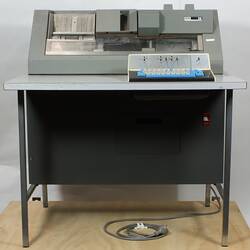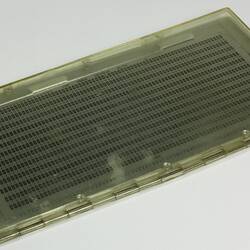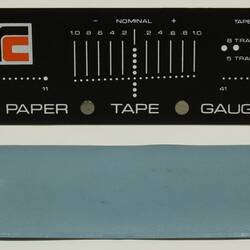Summary
Friden Flexowriter Code Chart.The Friden Flexowriter was used with the early Electrologica X1 computer. Originally an IBM development. The Flexowriter essentially worked like an electric typewriter that could produce punched paper tape or cards, read tape or cards and also typed the information. This chart was used by donor as an indispensable handy reference for remembering the code arrangement of Friden Flexowriters. Donor worked as a programmer for the company that provided Friden equipment in Australia.
Physical Description
The Code Chart is a flat rectangular piece of card with a table on one side filled with both numerical, symbolic and written information. The other side has a black and white photograph of a man and a range of Friden equipment and a paragraph advertising Flexowriters.
Significance
This item gives insight into the work practices of programmers in the 1950s and 1960s, who relied on manual tools such as templates to manually draw / write program flowcharts.
It shows the logical processes that computer systems of the time followed; that each proprietary computer design, such as IBM, UNIVAC and Friden, had their own conventions and requirements. The various stages and equipment involved in each is also evident from the options provided on the various templates - eg paper tape, punch card, manual operation, extract and so on.
The donor worked for the company that provided Friden equipment to Australia, and hence the Flexowriter that was used with CSIRAC in the early 1960s. Whilst most users of CSIRAC wrote their own programs using methods particular to CSIRAC, the Friden code chart and template packet shows how programs were prepared by Friden for other commercial clients who were using Friden equipment on more modern computers. The items therefore show an interesting comparison with CSIRAC, which in the early 1960s was already an obsolete computing technology, albeit a much used and still successful one.
More Information
-
Collecting Areas
-
Acquisition Information
Donation from Robyne Lovelock, 17 Jul 2003
-
Manufacturer
-
Inscriptions
'CODE CHART FLEXOWRITER automatic writing machines by FRIDEN...' 'SIX NEW AUTOMATIC WRITING MACHINES...Friden SAN LEANDRO CALIFORNIA SALES AND SERVICE THROUGHOUT THE WORLD A SUBSIDIARY OF THE SINGER GROUP...'
-
Classification
Computing & calculating, Digital computing, Paper tape equipment
-
Category
-
Discipline
-
Type of item
-
Overall Dimensions
254 mm (Length), 127 mm (Width)
-
Keywords





